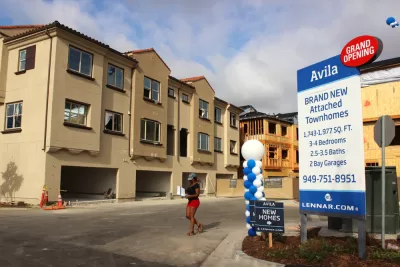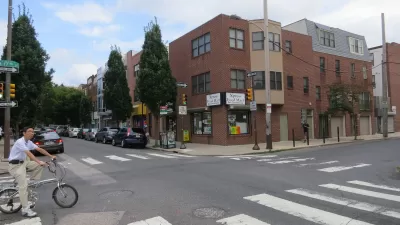New research helps explain why urban housing prices are escalating and how communities can increase affordability. It emphasizes the need to upzone sufficient urban land to create a large competitive market for parcels ready for infill development.

A new study by UCLA Professor Shane Phillips, Building Up the "Zoning Buffer": Using Broad Upzones to Increase Housing Capacity Without Increasing Land Values, emphasizes the need to maintain sufficient zoning buffer—the gap between the existing housing stock and the maximum number of homes allowed by current zoning—to increase housing affordability.
Phillips' research indicates that urban housing prices have risen because cities have downzoned, reducing the supply and driving up the price of parcels suitable for infill. For example, in 1960 Los Angeles had the zoning capacity to grow its housing stock by 300 percent; by 1980, this had fallen to 34 percent, declining to just 7 percent by 2016, as illustrated below. Downzoning did not stop population or employment growth, but it did reduce opportunities for additional housing. Over time, this shortage created our present-day housing crisis.

To combat this, many cities are upzoning to allow higher-density housing, usually in targeted locations such as along arterials or near transit stations. While this strategy may increase housing production in those areas, it can lead to higher land prices that erode the affordability of new homes. This study examines how the zoning buffer affects land values and the production and affordability of housing.
When zoning buffers are small, land with redevelopment potential remains scarce, and small-scale upzoning will cause land value increases that are largely captured by incumbent property owners. Larger-scale upzoning can create a large zoning buffer, reducing the scarcity of land with redevelopment potential, so property owners lack the leverage to demand more from a developer than a typical homebuyer. This allows developers to replace single-family houses with multiplexes, townhouses, and other types of multifamily housing, resulting in more moderately-priced development and lower housing prices.
Based on this analysis, Phillips argues that local or regional housing affordability can only be achieved through “broad upzoning,” defined as significant density increases on 25% to 50% of land in an area.
This study contributes to our understanding of why urban housing prices are escalating and how communities can increase affordability. It emphasizes the importance of scale—the need to upzone sufficient urban land—to create a large competitive market for parcels ready for moderately-priced infill development.

Alabama: Trump Terminates Settlements for Black Communities Harmed By Raw Sewage
Trump deemed the landmark civil rights agreement “illegal DEI and environmental justice policy.”

Planetizen Federal Action Tracker
A weekly monitor of how Trump’s orders and actions are impacting planners and planning in America.

The 120 Year Old Tiny Home Villages That Sheltered San Francisco’s Earthquake Refugees
More than a century ago, San Francisco mobilized to house thousands of residents displaced by the 1906 earthquake. Could their strategy offer a model for the present?

Ken Jennings Launches Transit Web Series
The Jeopardy champ wants you to ride public transit.

BLM To Rescind Public Lands Rule
The change will downgrade conservation, once again putting federal land at risk for mining and other extractive uses.

Indy Neighborhood Group Builds Temporary Multi-Use Path
Community members, aided in part by funding from the city, repurposed a vehicle lane to create a protected bike and pedestrian path for the summer season.
Urban Design for Planners 1: Software Tools
This six-course series explores essential urban design concepts using open source software and equips planners with the tools they need to participate fully in the urban design process.
Planning for Universal Design
Learn the tools for implementing Universal Design in planning regulations.
Clanton & Associates, Inc.
Jessamine County Fiscal Court
Institute for Housing and Urban Development Studies (IHS)
City of Grandview
Harvard GSD Executive Education
Toledo-Lucas County Plan Commissions
Salt Lake City
NYU Wagner Graduate School of Public Service




























